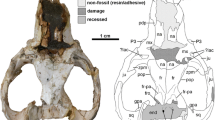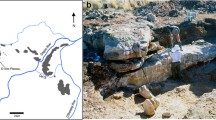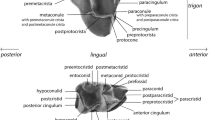Abstract
Djarthia murgonensis, a new genus and species of marsupial from the early Eocene Tingamarra Local Fauna of Murgon in southeastern Queensland, is described on the basis of dental material. The combination of marsupial synapomorphies and symplesiomorphies present in D. murgonensis suggests phylogenetic placement within either Didelphidae or Australidelphia. Tarsal morphology, fundamental to the concepts of Ameridelphia and Australidelphia respectively, is not yet known for this taxon. Consequently, it cannot be assigned to either clade with confidence. If this taxon is australidelphian, it constitutes support for the hypothesis that the common ancestor of the Australian marsupial radiation was didelphoid-like in dental features. Some previous authors have contended that marsupial faunas of South America and Australia are manifestly distinct, excepting for the australidelphian affinity of South American microbiotheres. However, because tarsal anatomy is unknown in some generalized Australian fossil taxa, including D. murgonensis, and character analysis reveals that no synapomorphies of the dentition unequivocally define either Ameridelphia or Australidelphia to the exclusion of the other, we consider this interpretation to be premature. In short, available evidence neither supports nor refutes the argument of distinct South American and Australasian marsupial faunas. A further ramification is the need to reconsider the phylogenetic position of Ankotarinja tirarensis and Keeuna woodburnei. These central Australian fossil taxa might be referred to either Australidelphia or Ameridelphia, and it is recommended that both be treated as Marsupialia incertae sedis until further material comes to light.
Similar content being viewed by others
LITERATURE CITED
Abbie, A. A. (1937). Some observations on the major subdivisions within the Marsupialia with special reference to the position of the Peramelidae and Caenolestidae. J. Anat. 71: 429–435.
Aplin, K., and Archer, M. (1987). Recent advances in marsupial systematics, with a new, syncretic classification. In: Possums and Opossums: Studies in Evolution, M. Archer, ed., pp. xv-lxxii, Surrey Beatty and Sons, Sydney.
Archer, M. (1975). Abnormal dental development and its significance in dasyurids and other marsupials. Mem. Qld. Mus. 17: 251–265.
Archer, M. (1976a). The basicranial region of marsupicarnivores (Marsupialia), interrelationships of carnivorous marsupials, and affinities of the insectivorous marsupial peramelids. Zool. J. Linn. Soc. 59: 217–322.
Archer, M. (1976b). The dasyurid dentition and its relationship to that of didelphids, thylacinids, borhyaenids (Marsupicarnivora) and peramelids (Peramelina: Marsupialia). Aust. J. Zool. Suppl. Ser. 39: 1–34.
Archer, M. (1976c). Miocene marsupicarnivores (Marsupialia) from central South Australia, Ankotarinja tirarensis gen. et. sp. nov., Keeuna woodburnei gen. et. sp. nov., and their significance in terms of early marsupial radiations. Trans. R. Soc. South Aust. 100: 53–73.
Archer, M. (1984). Origins and early radiations of marsupials. In: Vertebrate Zoogeography and Evolution in Australasia, M. Archer and G. Clayton, eds., pp. 585–625, Hesperian Press, Carlisle.
Archer, M., Hand, S., and Godthelp, H. (1988). A new order of zalambdodont marsupials. Science 239: 1528–1531.
Archer, M., Godthelp, H., and Hand, S. J. (1993). Early Eocene marsupial from Australia. Kaupia 3: 193–200.
Archer, M., Hand, S., and Godthelp, H. (1994). Riversleigh: The Story of Animals in Ancient Rainforests of Inland Australia, Reed Books, Sydney.
Archer, M., Hand, S., and Godthelp, H. (1995). Tertiary environmental and biotic change in Australia. In: Paleoclimate and Evolution, with Emphasis on Human Origins, E. S. Vrba, G. H. Denton, T. C. Partridge, and L. H. Burkle, eds., pp. 77–90, Yale University Press, New Haven.
Baverstock, E. R., Krieg, M., and Birrell, J. (1990). Evolutionary relationships of Australian marsupials as assessed by albumin immunology. Aust. J. Zool. 37: 273–287.
Bensley, B. A. (1903). On the evolution of the Australian Marsupialia, with remarks on the relationships of the marsupials in general. Trans. Linn. Soc. Lond. (Zool.) 9: 83–217.
Boles, W. E. (1997). Charadriiformes from the early Eocene Tingamarra Local Fauna, Murgon, Queensland, Australia. Conference on Australian Vertebrate Evolution, Palaeontology and Systematics, Perth, Abstracts, p. 15.
Cifelli, R. L. (1990a). Cretaceous mammals of southern Utah. I. Marsupials from the Kaiparopwits Formation. J. Vert. Paleontol. 10: 295–319.
Cifelli, R. L. (1990b). Cretaceous mammals of southern Utah. II. Marsupials and marsupial-like mammals from the Wahweap Formation (early Campanian). J. Vert. Paleontol. 10: 320–331.
Cifelli, R. L. (1993). Early Cretaceous mammal from North America and the evolution of marsupial dental characters. Proc. Natl. Acad. Sci. USA 90: 9413–9416.
Cifelli, R. L., and Johanson, Z. (1994). New marsupial from the Upper Cretaceous of Utah. J. Vert. Paleontol. 14: 292–295.
Cifelli, R. L., and de Muizon, C. (1997). Dentition of Kokopellia juddi, a primitive marsupial or near-marsupial from the medial Cretaceous of Utah. J. Mammal. Evol. 4: 241–258.
Cifelli, R. L., Rowe, T. B., Luckett, W. P., Banta, J., Reyes, R., and Howes, R. I. (1996). Fossil evidence for the origin of the pattern of marsupial tooth replacement. Nature 379: 715–718.
Crochet, J. Y. (1980). Les Marsupiaux du Tertiare d'Europe, Editions Foundation Singer-Polinac, Paris.
Dyzenchauz, F. J., Barros, M. A., and Kirsch, J. A. W. (1993). Dromiciops australis, G-banding analysis reinforces its close association to Australian marsupials. In: Abstracts of the Sixth International Theriological Congress, Sydney, p. 82.
Flower, W. H. (1867). On the development and succession of teeth in the Marsupialia. Phil. Trans. R. Soc. Lond. 157: 631–641.
Fox, R. C. (1987). Palaeontology and the evolution of marsupials. In: Possums and Opossums: Studies in Evolution, M. Archer, ed., pp. 161–169, Surrey Beatty and Sons, Sydney.
Gallardo, M. H., and Patterson, B. D. (1987). An additional 14 chromosome karyotype and sex chromosome mosaicism in South American marsupials. Fieldiana Zool. 39: 111–115.
Gemmell, N. J., and Westerman, M. (1994). Phylogenetic relationships within the class Mammalia: A study using mitochondrial 12S RNA sequences. J. Mammal. Evol. 2: 3–23.
Godthelp, H., Archer, M., Cifelli, R., Hand, S. J., and Gilkeson, C. F. (1992). Earliest known Australian Tertiary mammal fauna. Nature 356: 514–516.
Hall, L. S. (1987). Syndactyly in marsupials—Problems and prophecies. In: Possums and Opossums: Studies in Evolution, M. Archer, ed., pp. 245–255, Surrey Beatty and Sons, Sydney.
Hand, S., Novacek, M., Godthelp, H., and Archer, M. (1994). First Eocene bat from Australia. J. Vert. Paleontol. 14: 375–381.
Hershkovitz, P. (1992). Ankle bones: The Chilean opossum “Dromiciops gliroides” Thomas, and marsupial phylogeny. Bonn. Zool. Beitr. 43: 181–213.
Hershkovitz, P. (1995). The staggered marsupial third lower incisor: Hallmark of cohort Didelphimorphia, and description of a new genus and species with staggered i3 from the Albanian (Lower Cretaceous) of Texas. Bonn. Zool. Beitr. 45: 153–169.
Hume, I. D. (1982). Digestive Physiology and Nutrition of Marsupials, Cambridge University Press, Cambridge.
Illiger, C. (1811). Podromus Systematis Mammalian et Avium Additis Terminis Zoographicis Utriudque Classis, C. Salfeld, Berlin.
Janke, A., Xu, X. F., and Arnason, U. (1997). The complete mitochondrial genome of the Wallaroo (Macropus robustus) and the phylogenetic relationships among Monotremata, Marsupialia, and Eutheria. Proc. Natl. Acad. Sci. USA 94: 1276–1281.
Johanson, Z. (1994). New information concerning the late Cretaceous marsupial Albertatherium Fox, 1971. J. Vert. Paleontol. 14: 595–602.
Johanson, Z. (1996a). Revision of the Late Cretaceous North American marsupial genus Alphadon. Palaeontographica 242: 127–184.
Johanson, Z. (1996b). New marsupial from the Fort Union Formation, Swain Quarry, Wyoming. J. Paleontol. 70: 1023–1031.
Kielan-Jaworowska, Z., and Nessov, L. A. (1990). On the metatherian nature of the Deltatheroidea, a sister group of Marsupialia. Lethaia 23: 1–10.
Kirsch, J. A. W. (1977). The comparative serology of Marsupialia, and a classification of marsupials. Aust. J. Zool. Suppl. Ser. 52: 1–152.
Kirsch, J. A. W. (1984). Marsupial origins: taxonomic and biological considerations. In: Vertebrate Zoogeography and Evolution in Australasia, M. Archer and G. Clayton, eds., pp. 109–124, Hesperian Press, Perth.
Kirsch, J. A. W., Dickerman, A. W., Reig, O. A., and Springer, M. S. (1991). DNA hybridisation evidence for the Australian affinity of the American marsupial Dromiciops australis. Proc. Natl. Acad. Sci. USA 88: 10465–10469.
Kirsch, J. A. W., Lapointe, L. J., and Springer, M. S. (1997). DNA-hybridisation studies of marsupials and their implications for metatherian classification. Aust. J. Zool. 45: 211–280.
Luckett, W. P. (1993). An ontogenetic assessment of dental homologies in therian mammals. In: Mammal Phylogeny; Mesozoic Differentiation, Multituberculates, Monotremes, Early Therians and Marsupials, F. S. Szalay, M. J. Novacek, and M. C. McKenna, eds., pp. 182–204, Springer-Verlag, New York.
Luckett, W. P. (1994). Suprafamilial relationships within Marsupialia: Resolution and discordance from multidisciplinary data. J. Mammal. Evol. 2: 255–283.
Marenssi, S. A., Reguero, M. A., Santillana, S. N., and Vizcaino, S. F. (1994). Review of Eocene land mammals from Seymour Island, Antarctica: Palaeobiogeographical implications. Antarc. Sci. 6: 3–15.
Marshall, L. G. (1987). Systematics of Itaboraian (middle Paleocene) age “opossum-like” marsupials from the limestone Quarry at Sao José de Itaboraí, Brazil. In: Possums and Opossums: Studies in Evolution, M. Archer, ed., pp. 91–160, Surrey Beatty and Sons, Sydney.
Marshall, L. G., and Muizon, C. de (1988). The dawn of the age of mammals in South America. Natl. Geogr. Res. 4: 23–55.
Marshall, L. G., and Muizon, C. de (1995). Pucadelphys andinus (Marsupialia, Mammalia) from the early Paleocene of Bolivia. Part II. The skull. Mem. Mus. Nat. Hist. Nat. 165: 21–90.
Marshall, L. G., Case, J. A., and Woodburne, M. O. (1990). Phylogenetic relationships of the families of marsupials. In: Current Mammalogy, Vol. 2, H. H. Genoways, ed., pp. 433–505, Plenum Press, New York.
Maxon, L. R., Sarich, V. M., and Wilson, A. C. (1975). Continental drift and the use of albumin as an evolutionary clock. Nature 225: 397–400.
Mellet, J. S. (1984). Autocclusal mechanisms in the carnivore dentition. Aust. Mammal. 8: 233–238.
Muirhead, J., and Filan, S. (1995). Yarala burchfieldi (Peramelemorphia) from Oligo-Miocene deposits of Riversleigh, northwestern Queensland. J. Paleontol. 59: 127–134.
Muirhead, J., and Wroe, S. (1998). A new genus and species, Badjcinus turnbulli (Thylacinidae: Marsupialia), from the late Oligocene of Riversleigh, northern Australia, and an investigation of thylacinid phylogeny. J. Vert. Paleontol. 18: 612–626.
Muizon, C. de (1992). La fauna de mamiferos de Tiupampa (Paleoceno Inferior, Formacíon Santa Lucía), Bolivia. In: Fossils y facies de Bolivia, Vol. I. Vertebrados, R. Suarez-Soruco, ed., pp. 575–624, Revista Técnica de YPFB, Santa Cruz.
Muizon, C. de (1994). A new carnivorous marsupial from the Palaeocene of Bolivia and the problem of marsupial monophyly. Nature 370: 208–211.
Muizon, C. de (1998). Mayulestes ferox, a borhyaenoid (Metatheria, Mammalia) from the early Palaeocene of Bolivia. Phylogenetic and palaeobiologic implications. Geodiversitas 20: 19–142.
Muizon, C. de, Cifelli, R. L., and Céspedes Paz, R. (1997). The origin of the dog-like marsupials of South America. Nature 389: 486–489.
Reig, O. A., Kirsch, J. A. W., and Marshall, L. J. (1987). Systematic relationships of the living and Neocenozoic American “opossum-like” marsupials (suborder Didelphimorphia), with comments on the classification of these and the Cretaceous and Paleogene New World and European metatherians. In: Possums and Opossums: Studies in Evolution, M. Archer, ed., pp. 1–89, Surrey Beatty and Sons, Sydney.
Retief, J. D., Krajewski, C., Westerman, M., Winkfien, R. J., and Dixon, G. H. (1995). Molecular phylogeny and evolution of marsupial protoamine P1 genes. Proc. Roy. Soc. Lond. B 259: 7–14.
Richardson, B. J. (1988). A new view of the relationships of Australian and American marsupials. Aust. Mammal. 11: 71–73.
Ride, W. D. L. (1964). A review of Australian fossil marsupials. J. Roy. Soc. West. Aust. 47: 97–131.
Rothecker, J., and Storer, J. E. (1996). The marsupials of the Lac Pelletier Lower Fauna, middle Eocene (Duchesnean) of Saskatchewan. J. Vert. Paleontol. 16: 770–774.
Rougier, G. W., Wible, J. R., and Novacek, M. J. (1998). Implications of Deltatheridium specimens for early marsupial history. Nature 369: 459–463.
Salisbury, S. W., and Willis, P. M. A. (1996). A new crocodylian from the early Eocene of southeastern Queensland and a preliminary investigation of the phylogenetic relationships of crocodyloids. Alcheringa 20: 179–226.
Scanlon, J. (1993). Madtsoiid snakes from the Eocene Tingamarra Fauna of eastern Queensland. Kaupia 3: 3–8.
Sharman, G. B. (1982). Karyotypic similarities between Dromiciops australis (Microbiotheriidae, Marsupialia) and some Australian marsupials. In: Carnivorous Marsupials, M. Archer, ed., pp. 711–714, Royal Zoological Society of New South Wales, Sydney.
Shirley, J. (1897). Vocabularies of the Gowrburra and Koolaburra tribes. Proc. Roy. Soc. Qld. 12: 1–9.
Springer, M. S., Westerman, M., and Kirsch, J. A. W. (1994). Relationships among orders and families of marsupials based on 12S ribosomal DNA sequences and the timing of the marsupial radiation. J. Mammal. Evol. 2: 85–115.
Springer, M. S., Kirsch, J. A. W., and Case, J. A. (1996). The chronicle of marsupial evolution. In: Molecular Evolution and Adaptive Radiation, T. J. Givnish and K. J. Sytsma, eds., Cambridge University Press, Cambridge.
Szalay, F. S. (1982). A new appraisal of marsupial phylogeny and classification. In: Carnivorous Marsupials, M. Archer, ed., pp. 621–640, Royal Zoological Society of New South Wales, Sydney.
Szalay, F. S. (1993). Metatherian taxon phylogeny: Evidence and interpretation from the cranioskeletal system. In: Mammal Phylogeny: Mesozoic Differentiation, Multituberculates, Monotremes, Early Therians, and Marsupials, F. S. Szalay, M. J. Novacek, and M. C. McKenna, eds., pp. 216–242, Springer-Verlag, New York.
Szalay, F. S. (1994). Evolutionary History of the Marsupialia and an Analysis of Osteological Characters, Cambridge University Press, New York.
Szalay, F. S., and Trofimov, B. A. (1996). The Mongolian Late Cretaceous Asiatherium, and the early phylogeny and paleobiogeography of Metatheria. J. Vert. Paleontol. 16: 474–509.
Temple-Smith, P. (1987). Sperm structure and marsupial phylogeny. In: Possums and Opossums: Studies in Evolution, M. Archer, ed., pp. 171–193, Surrey-Beatty and Sons, Chipping Norton.
Veevers, J. J. (1991). Phanerozoic Australia in the changing configuration of proto-Pangea through Gondwanaland and Pangea to the present dispersed continents. Aust. Syst. Bot. 4: 1–11.
Westerman, M., and Edwards, D. (1991). The relationship of Dromiciops australis to other marsupials: Data from DNA-DNA hybridisation studies. Aust. J. Zool. 39: 123–130.
Willis, P. M. A., Molnar, R. E., and Scanlon, J. D. (1993). An early Eocene crocodilian from Murgon, southeastern Queensland. Kaupia 3: 27–33.
Woodburne, M. O., and Case, J. A. (1996). Dispersal, vicariance, and the late Cretaceous to early Tertiary land mammal biogeography from South America to Australia. J. Mammal. Evol. 3: 121–161.
Woodburne, M. O., MacFadden, J. A., Case, J. A., Springer, M. S., Pledge, N. S., Power, J. D., Woodburne, J. M., and Springer, K. B. (1993). Land mammal biostratigraphy and magnetostratigraphy of the Etadunna Formation (late Oligocene) of South Australia. J. Vert. Paleontol. 13: 483–515.
Wroe, S. (1996). Muribacinus gadiyuli (Thylacinidae, Marsupialia), a very plesiomorphic thylacinid from the Miocene of Riversleigh, northwestern Queensland, and the problem of paraphyly for the Dasyuridae. J. Paleontol. 70: 1032–1044.
Wroe, S. (1997a). A reexamination of proposed morphology-based synapomorphies for the families of Dasyuromorphia (Marsupialia): Part I, Dasyuridae. J. Mammal. Evol. 4: 19–52.
Wroe, S. (1997b). Mayigriphus orbus, A Miocene dasyuromorphian (Marsupialia) from Riversleigh, northwestern Queensland. Mem. Qld. Mus. 42: 439–448.
Wroe, S. (1999). The geologically oldest dasyurid (Dasyuromorphia), from middle Miocene deposits of Riversleigh, northwestern Queensland. Palaeontology (in press).
Wroe, S., Brammall, J., and Cooke, B. N. (1998). The skull of Ekaltadeta ima (Marsupialia, Hypsiprymnodontidae?): An analysis of some marsupial cranial features and a re-investigation of propleopine phylogeny, with notes on the inference of carnivory in mammals. J. Paleontol. 72: 738–751.
Author information
Authors and Affiliations
Corresponding author
Rights and permissions
About this article
Cite this article
Godthelp, H., Wroe, S. & Archer, M. A New Marsupial from the Early Eocene Tingamarra Local Fauna of Murgon, Southeastern Queensland: A Prototypical Australian Marsupial?. Journal of Mammalian Evolution 6, 289–313 (1999). https://doi.org/10.1023/A:1020517808869
Issue Date:
DOI: https://doi.org/10.1023/A:1020517808869




